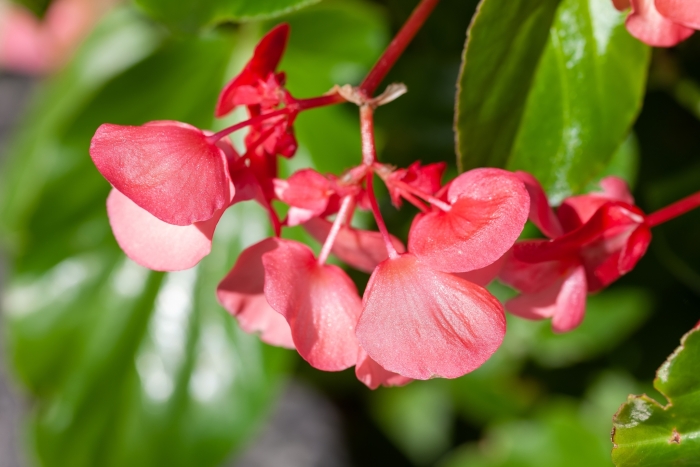Wax Begonia
(Begonia semperflorens)
Wax Begonia (Begonia semperflorens)
/
/

© Richard Stovall
CC BY 4.0
Image By:
© Richard Stovall
Recorded By:
Copyright:
CC BY 4.0
Copyright Notice:
Photo by: © Richard Stovall | License Type: CC BY 4.0 | License URL: http://creativecommons.org/licenses/by/4.0/ | Uploader: arctic_mongoose | Publisher: iNaturalist |






















Estimated Native Range
Summary
Begonia semperflorens, commonly known as wax begonia, is an herbaceous perennial that originated from the hybridization of Begonia cucullata and other Begonia species, with its progenitors native to South America, specifically Argentina, Brazil, Paraguay, and Uruguay. Wax begonias typically grow to 6-12 inches (15-30 cm) in height and width, featuring succulent, glossy leaves that are green or bronze in color and almost symmetrical in shape. The plant is well-known for its continuous blooming throughout the summer, producing clusters of red, pink, or white flowers that are modest in size but quite showy due to their abundance.
Wax begonia is valued for its long flowering season, low maintenance, and ability to thrive in a variety of conditions, making it a popular choice for urban landscapes, borders, and as a bedding plant. It is also used for container gardening and indoor cultivation. In terms of care, it requires well-drained soil and can grow in a range of light conditions, from full sun to shade, although it prefers dappled light or afternoon shade in hot climates. Overwatering should be avoided to prevent root rot. While generally pest-resistant, it can be susceptible to powdery mildew and should be monitored for fungal diseases. In regions like Florida and Georgia, it can become invasive, so gardeners should manage its spread responsibly.CC BY-SA 4.0
Wax begonia is valued for its long flowering season, low maintenance, and ability to thrive in a variety of conditions, making it a popular choice for urban landscapes, borders, and as a bedding plant. It is also used for container gardening and indoor cultivation. In terms of care, it requires well-drained soil and can grow in a range of light conditions, from full sun to shade, although it prefers dappled light or afternoon shade in hot climates. Overwatering should be avoided to prevent root rot. While generally pest-resistant, it can be susceptible to powdery mildew and should be monitored for fungal diseases. In regions like Florida and Georgia, it can become invasive, so gardeners should manage its spread responsibly.CC BY-SA 4.0
Plant Description
- Plant Type: Herb
- Height: 0.5-1 feet
- Width: 0.5-1 feet
- Growth Rate: Moderate
- Flower Color: Pink, Red, White
- Flowering Season: Summer, Fall
- Leaf Retention: Evergreen
Growth Requirements
- Sun: Part Shade, Full Shade
- Water: Medium
- Drainage: Fast, Medium
Common Uses
Border Plant, Butterfly Garden, Groundcover, Low Maintenance, Potted Plant, Showy Flowers, Street Planting
Natural Habitat
Native to South America, specifically Argentina, Brazil, Paraguay, and Uruguay, and a hybridized species
Other Names
Common Names: Perennial Begonia , Bedding Begonia
Scientific Names: Begonia semperflorens , Begonia hookeri , Begonia sellowii , Begonia semperflorens f. flavescens , Begonia semperflorens var. hookeri , Begonia semperflorens var. sellowii , Begonia semperflorens var. sellowii
GBIF Accepted Name: